Gyudmed Tantric University, Hunsur, Karnataka, India - This morning, as the monks gathered in the assembly hall of Gyudmed Tantric University they recited His Holiness the Dalai Lama’s name mantra: Om Ah Guru Vajradhara Bhattaraka Manjushri Vagindra Sumati Jnana Shasana Dhara Samudra Shri Bhadra Sarva Siddhi Hum Hum. As His Holiness entered the hall and walked towards the throne, they switched to chanting the Mig-tse-ma verse in praise of Jé Tsongkhapa.
The ceremony began with the Abbot, Geshé Ngawang Sangyé, offering a khata, a silk scarf, that he unfurled over the table in front of His Holiness’s throne and then took his seat. The chant master led a recitation of the praise to Jetsun Sherab Sengé.
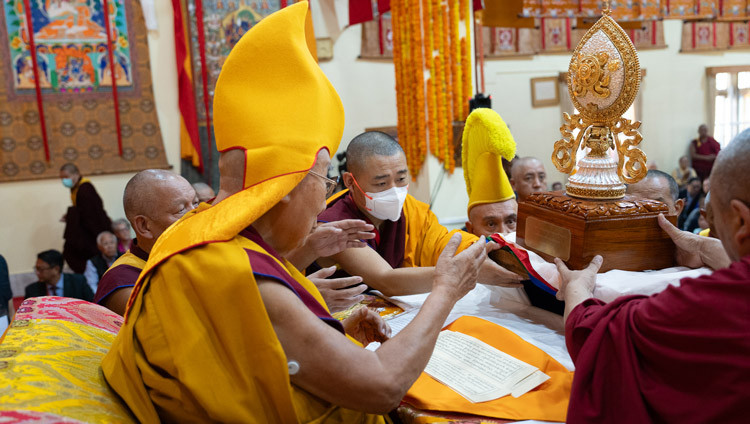
To start with, Gyudmed Tantric University presented His Holiness, who the monks consider to be their master and custodian of the teaching and practice traditions of Gyudmed Dratsang, with a Master of the Sutra and Tantra Tradition of Gyudmed Tantric University Award, in the form of a blazing wheel made of gold and silver. It was conferred with the following dedication.
“Since the reestablishment of this monastery in exile Your Holiness has kindly looked after us. You have not only encouraged the study and practice of our traditional curriculum, but also urged us to become better acquainted with modern science.
“Your Holiness has given teachings on the three major Gelukpa tantric practices of Guhyasamaja, Chakrasamvara Heruka and Yamantaka, the Four Annotations of Tantra, the Four Mindfulnesses and other topics. We are unable to repay even a small portion of your kindness. You have also given us profound teachings and pith instructions relevant to Gyudmed Tantric University. Your care for us has been comparable to the way a mother looks after her son. We, the monks of Gyudmed Tantric University, are presenting you with this award in acknowledgement that you are our master”
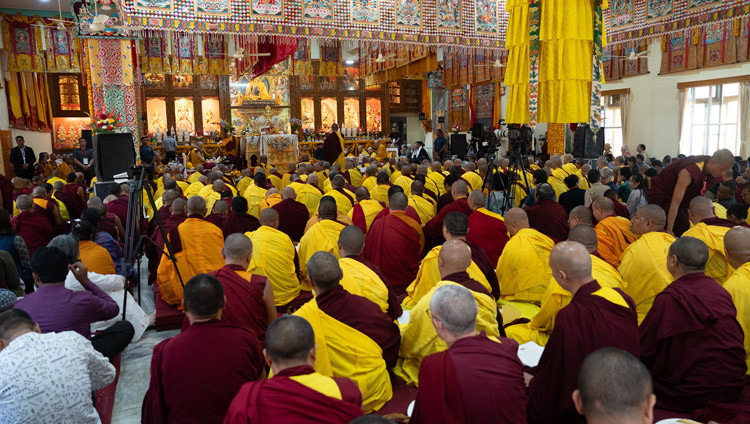
Next came a verse, which will be included in the monastery’s lineage prayer, that His Holiness has composed at the monastery’s request:
I make supplications at your feet, O Tenzin Gyatso
The Unrivalled Holder of the Lotus,
Who reveals the excellent path of the King of Tantras, Guhyasamaja,
The most sublime precious jewel in the three worlds of existence.
While the Abbot of Gyudmed offered His Holiness a cushion marked with a crossed vajra, this verse was said:
May all sentient beings become enlightened
and quickly acquire these thrones:
An elephant throne, symbolising the possession of the ten powers;
A lion throne denoting fearlessness;
A horse throne indicating swift legs;
A peacock throne showing possession of the ten subjugating powers;
A garuda throne, representing unhindered ability;
A jewel throne, the source of wish-fulfilment;
A lotus throne representing being unsullied by faults;
A sun and moon throne,
and the natural clear light.
Om siddhi raja ye svaha
There followed a recitation of verses in praise of Jé Tsongkhapa by Khedup Jé entitled the ‘Most Glorious One of the Three Worlds’. After that came a ‘Praise of the Buddha - The Unrivalled Lion of the Shakyas’, which begins:
Indra, king of the gods,
his enemy the Asura leader,
Pramudita, celestial musician king,
naga kings and great rishis
beautify your lotus feet with the jewels of their crowns.
Glorious body bathing in splendor of its golden glow,
voice unrivaled even by melodies of celestial musicians,
mind brighter than ten million suns,
guide supreme for infinite living beings,
paragon of the Shakyas.
Moon and stars on a cloudless night
appear crystal-clear in the midst of a lake,
so in the clear waters of my untroubled mind
are your qualities reflected one by one.
And ends:
Within your deeds however,
no trace of neglect or indifference
toward any disciple is found.
Solely by my own faults, therefore,
am I rendered so unfortunate,
and no failing is attached to you.
Therefore, until under the bodhi tree
I emerge victorious over the hosts of Mara,
I pray to be cared for life after life by you
and never tire of your nectar-like words.
Tea was distributed, offered and blessed with verses composed by Gendun Gyatso, the Second Dalai Lama:
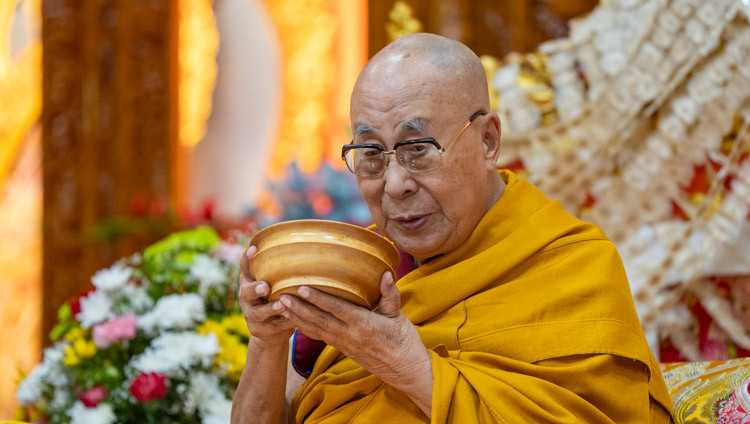
The Prince of Suddhodana, who was an unmatched guide of beings,
Manjushri, the master of wisdom
and Ajita (Maitreya), the master of love and compassion
I pray to you. Please, bless me.
Lord Amitabha’s emanation, the omniscient Dipankara,
who was the crowning jewel in these degenerate times
Conqueror Dromtönpa, the emanation of Lord Avalokiteshvara
Please accept this uncontaminated offering of nectar.
Tsongkhapa, the monk emanation of Manjushri,
who is the sole progenitor of Buddhas
Please be fully contented with the great bliss nectar
flowing from the clouds cast by your compassionate blessings.
Manjushri, the one and only father of Buddhas
My lasting source of refuge
Please reside in the lotus of my heart
and accept these immeasurable ambrosial offerings.
My own body being in the nature of a deity
though not craving the nectar of hundred flavours
What a great bliss that I enjoy at will
Emaho! how wonderful and fortunate!
Rice was distributed and the prayer invoking the series of manifestations of Avalokiteshvara (Chenrezig), in India and Tibet, including kings, scholars and translators and such luminaries as Drontönpa, Sachen Kunga Nyingpo, Sangye Gompa, as well as Gedun Drup and the lineage of Dalai Lamas, was said. This is the verse in praise of His Holiness the present Dalai Lama:
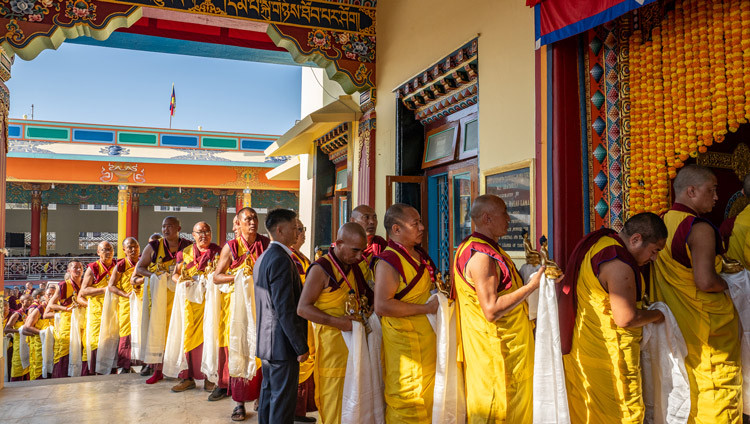
Gaining mastery of the speech of Heroic Manjushri,
Your excellent wisdom, as deep as the ocean,
Upholds the Victor’s Teaching;
You are sovereign protector of the triple world;
O Incomparable Lord — I pray to you!
A long mandala offering was performed to request His Holiness the Dalai Lama to live long, followed by a recitation of the Prayer for His Holiness’s Long Life by his two Tutors. A Tsog offering called Tsaru Ganachakra was blessed according to Guhyasamaja tantric system and offered offered within the context of Guhyasamaja tantra.
His Holiness addressed the congregation:
“Since this prayer for my long life is being held here at Gyudmed Tantric University I will give the oral transmission of a verse to be included in the prayer to the lineage lamas as I have been requested to do.
“The complete teaching of the Buddha has spread in Tibet, teaching that has been practised without a break in its transmission. The Tantric colleges of the Geluk tradition in particular have preserved this.
“With regard to myself, after I had received teachings, I became really interested in engaging in intensive study of Guhyasamaja Tantra based on the writings of Jé Tsongkhapa.
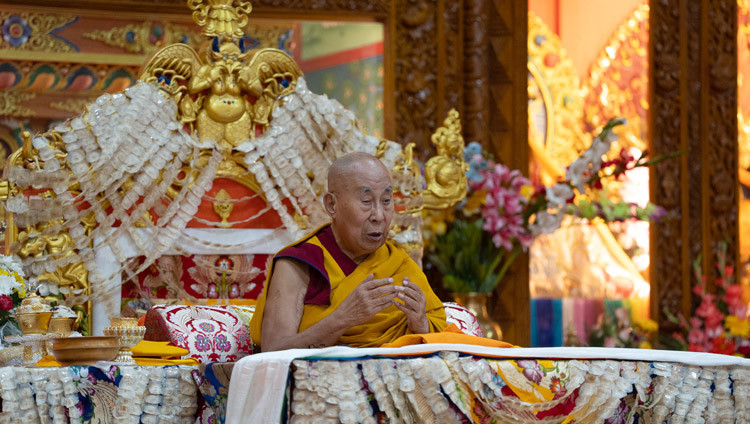
“In the Gyutö and Gyudmed Tantric Colleges study of Guhyasamaja is part of your standard curriculum, which has served the purpose of keeping this tradition alive until today.
“Next, I’ve been asked to give the oral transmission of a text entitled: ‘A Direct Guided Instruction on How to Practice the Five Stages of Guhyasamaja in a Single Sitting’. Following a salutation to the Teacher of Guhyasamaja Tantra and your own Lama, who are inseparable, and the pledge to compose the text, the author gives two major divisions of the teaching:
1. Preliminary practices and
2. Actual practice (of the five stages of the completion phase of Guhyasamaja).
1. Preliminary practices has two parts:
1a) Purifying negativities, karmas and impediments (to the actual practice) through meditation and recitation of the Vajrasattva sadhana and
1b) Gathering the conducive conditions for collecting positive factors through meditation on Guru Yoga.”
Today, His Holiness completed section 1a). He explained how to purify negativities through meditation on Vajrasattva and the recitation of his 100-syllable mantra. The second part of the preliminary practices and the remainder of the text have not been covered during this visit to Gyudmed Monastery.
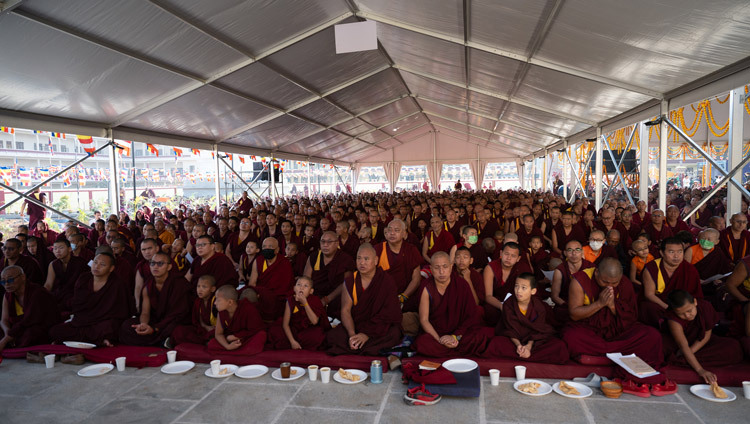
His Holiness emphasized how important it is to meditate on emptiness imbued with bodhichitta.
“Whatever you meditate on you should think of that object as being empty of inherent existence. That includes yourself and everything else, your friends and so forth. You should have a compassionate pure intention to help all sentient beings, to purify negativities, to meditate on emptiness and to engage in the practice of deity yoga.
“We recite these sadhanas every day. The important thing to keep in mind is that the purpose of sadhana practice is to integrate the practice within yourself. In other words, we should do whatever practice we do with a sincere heart. If we don’t give serious thought to how we practice it just becomes another routine. That’s all I wish to say.” His Holiness’s words inspired gentle applause.
A thanksgiving mandala offering was performed, followed by the prayer for His Holiness’s long life in a single verse:
In the land encircled by snow mountains
You are the source of all happiness and good;
All-powerful Avalokiteshvara, Tenzin Gyatso,
Please remain until cyclic existence ends.
Finally, after the recitation of a Praise of Amitayus and the Prayer for the Flourishing of the Teaching came the Verses of Auspiciousness from Guhyasamaja Tantra.












